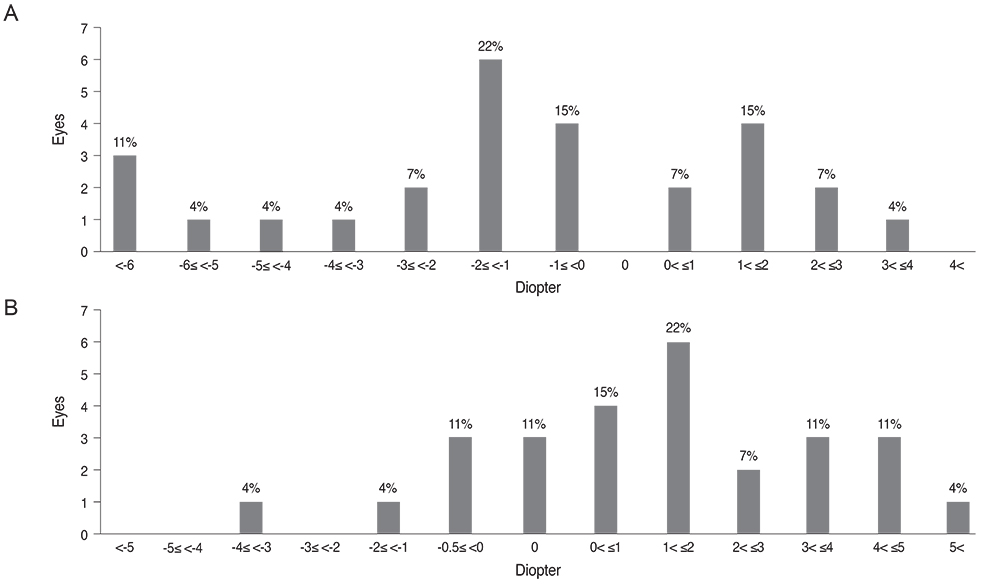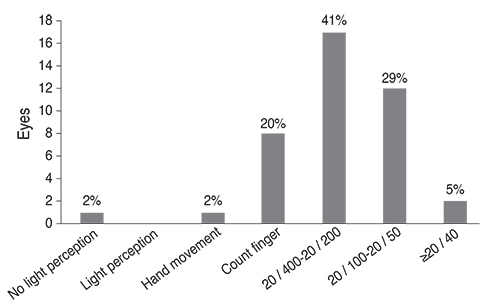Korean J Ophthalmol.
2014 Dec;28(6):479-485. 10.3341/kjo.2014.28.6.479.
Congenital Aniridia: Long-term Clinical Course, Visual Outcome, and Prognostic Factors
- Affiliations
-
- 1Department of Ophthalmology, Ilsan Paik Hospital, Inje University College of Medicine, Goyang, Korea.
- 2Department of Ophthalmology, Seoul National University Hospital, Seoul, Korea. ysyu@snu.ac.kr
- 3Seoul Artificial Eye Center, Seoul National University Hospital Clinical Research Institute, Seoul, Korea.
- KMID: 2345825
- DOI: http://doi.org/10.3341/kjo.2014.28.6.479
Abstract
- PURPOSE
To describe the clinical course of congenital aniridia and to evaluate prognostic factors for visual outcome after long-term follow-up.
METHODS
The medical records of 120 eyes from 60 patients with congenital aniridia were retrospectively reviewed. The prevalence and clinical course of ophthalmic characteristics, systemic disease, refractive errors, and visual acuity were assessed. Prognostic factors for final visual outcomes were analyzed.
RESULTS
Aniridic keratopathy developed in 82 (69%) of 119 eyes. Macular hypoplasia was observed in 70 eyes of 35 patients (91%). Cataract was observed in 63 of 120 eyes (53%). Nystagmus was present in 41 patients (68% of 60 patients) at the initial visit but decreased in five patients (8% of 60 patients). Ocular hypertension was detected in 19 eyes (20% of 93 eyes), six (32% of 19 eyes) of which developed secondarily after cataract surgery. The mean changes in spherical equivalent and astigmatism during the follow-up period were -1.10 and 1.53 diopter, respectively. The mean final visual acuity was 1.028 logarithm of minimal angle of resolution. Nystagmus and ocular hypertension were identified as prognostic factors for poor visual outcome.
CONCLUSIONS
Identification of nystagmus and ocular hypertension was important to predict final visual outcome. Based on the high rate of secondary ocular hypertension after cataract surgery, careful management is needed.
Keyword
MeSH Terms
-
Adolescent
Adult
Aniridia/*diagnosis/physiopathology
Cataract/diagnosis
Child
Child, Preschool
Corneal Diseases/diagnosis
Eye Abnormalities/diagnosis
Eye Diseases/*diagnosis/physiopathology
Follow-Up Studies
Humans
Infant
Infant, Newborn
Nystagmus, Pathologic/diagnosis
Ocular Hypertension/diagnosis
Prognosis
Retina/abnormalities
Retrospective Studies
Visual Acuity/*physiology
Young Adult
Figure
Cited by 1 articles
-
Clinical Features and Molecular Characteristics of Korean Patients with Congenital Aniridia
In Kyun Hahn, Dae Hee Kim, Hyun Taek Lim
J Korean Ophthalmol Soc. 2016;57(9):1441-1450. doi: 10.3341/jkos.2016.57.9.1441.
Reference
-
1. Ton CC, Hirvonen H, Miwa H, et al. Positional cloning and characterization of a paired box- and homeobox-containing gene from the aniridia region. Cell. 1991; 67:1059–1074.2. Glaser T, Walton DS, Maas RL. Genomic structure, evolutionary conservation and aniridia mutations in the human PAX6 gene. Nat Genet. 1992; 2:232–239.3. Churchill A, Booth A. Genetics of aniridia and anterior segment dysgenesis. Br J Ophthalmol. 1996; 80:669–673.4. Nelson LB, Spaeth GL, Nowinski TS, et al. Aniridia: a review. Surv Ophthalmol. 1984; 28:621–642.5. Eden U, Iggman D, Riise R, Tornqvist K. Epidemiology of aniridia in Sweden and Norway. Acta Ophthalmol. 2008; 86:727–729.6. Eden U, Beijar C, Riise R, Tornqvist K. Aniridia among children and teenagers in Sweden and Norway. Acta Ophthalmol. 2008; 86:730–734.7. Mannens M, Bleeker-Wagemakers EM, Bliek J, et al. Autosomal dominant aniridia linked to the chromosome 11p13 markers catalase and D11S151 in a large Dutch family. Cytogenet Cell Genet. 1989; 52:32–36.8. Neuhann IM, Neuhann TF. Cataract surgery and aniridia. Curr Opin Ophthalmol. 2010; 21:60–64.9. Lee H, Khan R, O'Keefe M. Aniridia: current pathology and management. Acta Ophthalmol. 2008; 86:708–715.10. De la Paz MF, Alvarez de Toledo J, Barraquer RI, Barraquer J. Long-term visual prognosis of corneal and ocular surface surgery in patients with congenital aniridia. Acta Ophthalmol. 2008; 86:735–740.11. Lee H, Meyers K, Lanigan B, O'Keefe M. Complications and visual prognosis in children with aniridia. J Pediatr Ophthalmol Strabismus. 2010; 47:205–210.12. Schulze-Bonsel K, Feltgen N, Burau H, et al. Visual acuities "hand motion" and "counting fingers" can be quantified with the freiburg visual acuity test. Invest Ophthalmol Vis Sci. 2006; 47:1236–1240.13. Nishina S, Kohsaka S, Yamaguchi Y, et al. PAX6 expression in the developing human eye. Br J Ophthalmol. 1999; 83:723–727.14. Azuma N, Nishina S, Yanagisawa H, et al. PAX6 missense mutation in isolated foveal hypoplasia. Nat Genet. 1996; 13:141–142.15. McCulley TJ, Mayer K, Dahr SS, et al. Aniridia and optic nerve hypoplasia. Eye (Lond). 2005; 19:762–764.16. Holmstrom G, Eriksson U, Hellgren K, Larsson E. Optical coherence tomography is helpful in the diagnosis of foveal hypoplasia. Acta Ophthalmol. 2010; 88:439–442.17. Grove JH, Shaw MW, Bourque G. A family study of aniridia. Arch Ophthalmol. 1961; 65:81–94.18. Elsas FJ, Maumenee IH, Kenyon KR, Yoder F. Familial aniridia with preserved ocular function. Am J Ophthalmol. 1977; 83:718–724.19. Sonoda S, Isashiki Y, Tabata Y, et al. A novel PAX6 gene mutation (P118R) in a family with congenital nystagmus associated with a variant form of aniridia. Graefes Arch Clin Exp Ophthalmol. 2000; 238:552–558.20. Grant WM, Walton DS. Progressive changes in the angle in congenital aniridia, with development of glaucoma. Trans Am Ophthalmol Soc. 1974; 72:207–228.21. Park SH, Park YG, Lee MY, Kim MS. Clinical features of Korean patients with congenital aniridia. Korean J Ophthalmol. 2010; 24:291–296.22. Taylor RH, Ainsworth JR, Evans AR, Levin AV. The epidemiology of pediatric glaucoma: the Toronto experience. J AAPOS. 1999; 3:308–315.23. Eden U, Riise R, Tornqvist K. Corneal involvement in congenital aniridia. Cornea. 2010; 29:1096–1102.



